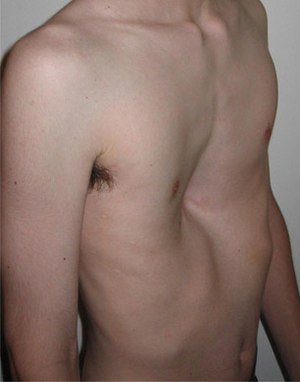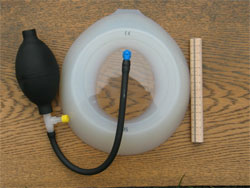Pectus excavatum: Difference between revisions
No edit summary |
CSV import |
||
| (One intermediate revision by the same user not shown) | |||
| Line 1: | Line 1: | ||
{{SI}} | |||
{{Infobox medical condition | |||
| name = Pectus excavatum | |||
| image = [[File:Pectus1.jpg|left|thumb]] | |||
| caption = A person with pectus excavatum | |||
| synonyms = Funnel chest, sunken chest | |||
| pronunciation = | |||
| specialty = [[Thoracic surgery]], [[Pediatrics]] | |||
| symptoms = [[Chest pain]], [[shortness of breath]], [[fatigue]] | |||
| complications = [[Cardiac compression]], [[respiratory issues]] | |||
| onset = [[Childhood]] | |||
| duration = [[Lifelong]] | |||
| causes = [[Genetic factors]], [[connective tissue disorders]] | |||
| risks = [[Marfan syndrome]], [[Ehlers-Danlos syndrome]] | |||
| diagnosis = [[Physical examination]], [[imaging studies]] | |||
| differential = [[Pectus carinatum]], [[scoliosis]] | |||
| prevention = None | |||
| treatment = [[Surgical repair]], [[physical therapy]] | |||
| medication = [[Pain management]] | |||
| prognosis = Generally good with treatment | |||
| frequency = 1 in 300-400 births | |||
}} | |||
[[File:Pectusexcavatum.png|thumb|Pectus excavatum]] | |||
[[File:Trichterbrust_im_Roentgenbild_des_Thorax_pa.jpg|left|thumb|X-ray of pectus excavatum]] | |||
[[File:Miseczka_prozniowa_Eckart_Klobe.jpg|left|thumb|Vacuum bell for pectus excavatum]] | |||
[[File:Stilleben_coach.jpg|left|thumb|Pectus excavatum]] | |||
[[Pectus excavatum]], also known as "funnel chest" or "sunken chest", is a congenital chest wall deformity characterized by a concave, or caved-in, appearance of the sternum. The severity of the condition varies between individuals, and it can range from a mild indentation to a severe depression, potentially impacting surrounding organs. | [[Pectus excavatum]], also known as "funnel chest" or "sunken chest", is a congenital chest wall deformity characterized by a concave, or caved-in, appearance of the sternum. The severity of the condition varies between individuals, and it can range from a mild indentation to a severe depression, potentially impacting surrounding organs. | ||
== Pathophysiology == | == Pathophysiology == | ||
Pectus excavatum results from an excessive growth and abnormal orientation of the costal cartilages, leading to the depression of the sternum. This growth disturbance is usually noted in the first year of life and becomes more pronounced during the rapid growth period of puberty. Although the exact cause is not known, it is believed to have a genetic component, as it frequently occurs in families and is often associated with other genetic disorders such as [[Marfan syndrome]] and [[Ehlers-Danlos syndrome]]. | Pectus excavatum results from an excessive growth and abnormal orientation of the costal cartilages, leading to the depression of the sternum. This growth disturbance is usually noted in the first year of life and becomes more pronounced during the rapid growth period of puberty. Although the exact cause is not known, it is believed to have a genetic component, as it frequently occurs in families and is often associated with other genetic disorders such as [[Marfan syndrome]] and [[Ehlers-Danlos syndrome]]. | ||
== Clinical Presentation == | == Clinical Presentation == | ||
Clinically, the hallmark of pectus excavatum is a visibly sunken sternum, which can become more pronounced with growth or physical activity. The condition may cause discomfort or pain in the chest and back, and it may also affect respiratory function in severe cases, leading to shortness of breath, especially during physical activity. It is also common for individuals with pectus excavatum to experience feelings of self-consciousness due to the appearance of their chest. | Clinically, the hallmark of pectus excavatum is a visibly sunken sternum, which can become more pronounced with growth or physical activity. The condition may cause discomfort or pain in the chest and back, and it may also affect respiratory function in severe cases, leading to shortness of breath, especially during physical activity. It is also common for individuals with pectus excavatum to experience feelings of self-consciousness due to the appearance of their chest. | ||
== Diagnosis == | == Diagnosis == | ||
Diagnosis of pectus excavatum is typically made based on physical examination. Imaging studies, such as chest X-rays, CT scans, or MRI, may be used to assess the severity of the depression and its effect on the heart and lungs. Pulmonary function tests may also be performed to evaluate any breathing difficulties. | Diagnosis of pectus excavatum is typically made based on physical examination. Imaging studies, such as chest X-rays, CT scans, or MRI, may be used to assess the severity of the depression and its effect on the heart and lungs. Pulmonary function tests may also be performed to evaluate any breathing difficulties. | ||
== Management and Treatment == | == Management and Treatment == | ||
The management of pectus excavatum depends on the severity of the symptoms and the impact on the patient's quality of life. Mild cases without significant symptoms or functional impairment may not require any specific treatment except for regular monitoring. | The management of pectus excavatum depends on the severity of the symptoms and the impact on the patient's quality of life. Mild cases without significant symptoms or functional impairment may not require any specific treatment except for regular monitoring. | ||
For moderate to severe cases, surgical correction may be recommended. The most common procedure is the Nuss procedure, a minimally invasive approach that involves the insertion of a curved metal bar to correct the shape of the sternum. Postoperative pain management is an essential part of the recovery process. | For moderate to severe cases, surgical correction may be recommended. The most common procedure is the Nuss procedure, a minimally invasive approach that involves the insertion of a curved metal bar to correct the shape of the sternum. Postoperative pain management is an essential part of the recovery process. | ||
Physical therapy exercises may also help to improve posture, increase lung capacity, and strengthen chest wall muscles. | Physical therapy exercises may also help to improve posture, increase lung capacity, and strengthen chest wall muscles. | ||
== Pectus_excavatum images == | |||
<gallery> | |||
File:Modified_ravitch_vienna.png|Modified Ravitch procedure | |||
File:Ravitch_Scar.jpg|Scar from Ravitch procedure | |||
File:Nuss_x-ray.jpg|X-ray after Nuss procedure | |||
</gallery> | |||
== References == | == References == | ||
* [https://www.ncbi.nlm.nih.gov/pmc/articles/PMC2695393/ Pectus Excavatum: History, Questions and Controversies] | * [https://www.ncbi.nlm.nih.gov/pmc/articles/PMC2695393/ Pectus Excavatum: History, Questions and Controversies] | ||
* [https://pubmed.ncbi.nlm.nih.gov/18485950/ The management of pectus excavatum: a comparative study of the Nuss and Ravitch procedures] | * [https://pubmed.ncbi.nlm.nih.gov/18485950/ The management of pectus excavatum: a comparative study of the Nuss and Ravitch procedures] | ||
* [https://www.ncbi.nlm.nih.gov/pmc/articles/PMC4281978/ Physical therapy for a child with pectus excavatum and bilateral hip dysplasia: a case report] | * [https://www.ncbi.nlm.nih.gov/pmc/articles/PMC4281978/ Physical therapy for a child with pectus excavatum and bilateral hip dysplasia: a case report] | ||
[[Category:Congenital disorders]] | [[Category:Congenital disorders]] | ||
[[Category:Respiratory diseases]] | [[Category:Respiratory diseases]] | ||
Latest revision as of 12:08, 14 April 2025

Editor-In-Chief: Prab R Tumpati, MD
Obesity, Sleep & Internal medicine
Founder, WikiMD Wellnesspedia &
W8MD medical weight loss NYC and sleep center NYC
| Pectus excavatum | |
|---|---|
 | |
| Synonyms | Funnel chest, sunken chest |
| Pronounce | N/A |
| Specialty | Thoracic surgery, Pediatrics |
| Symptoms | Chest pain, shortness of breath, fatigue |
| Complications | Cardiac compression, respiratory issues |
| Onset | Childhood |
| Duration | Lifelong |
| Types | N/A |
| Causes | Genetic factors, connective tissue disorders |
| Risks | Marfan syndrome, Ehlers-Danlos syndrome |
| Diagnosis | Physical examination, imaging studies |
| Differential diagnosis | Pectus carinatum, scoliosis |
| Prevention | None |
| Treatment | Surgical repair, physical therapy |
| Medication | Pain management |
| Prognosis | Generally good with treatment |
| Frequency | 1 in 300-400 births |
| Deaths | N/A |




Pectus excavatum, also known as "funnel chest" or "sunken chest", is a congenital chest wall deformity characterized by a concave, or caved-in, appearance of the sternum. The severity of the condition varies between individuals, and it can range from a mild indentation to a severe depression, potentially impacting surrounding organs.
Pathophysiology[edit]
Pectus excavatum results from an excessive growth and abnormal orientation of the costal cartilages, leading to the depression of the sternum. This growth disturbance is usually noted in the first year of life and becomes more pronounced during the rapid growth period of puberty. Although the exact cause is not known, it is believed to have a genetic component, as it frequently occurs in families and is often associated with other genetic disorders such as Marfan syndrome and Ehlers-Danlos syndrome.
Clinical Presentation[edit]
Clinically, the hallmark of pectus excavatum is a visibly sunken sternum, which can become more pronounced with growth or physical activity. The condition may cause discomfort or pain in the chest and back, and it may also affect respiratory function in severe cases, leading to shortness of breath, especially during physical activity. It is also common for individuals with pectus excavatum to experience feelings of self-consciousness due to the appearance of their chest.
Diagnosis[edit]
Diagnosis of pectus excavatum is typically made based on physical examination. Imaging studies, such as chest X-rays, CT scans, or MRI, may be used to assess the severity of the depression and its effect on the heart and lungs. Pulmonary function tests may also be performed to evaluate any breathing difficulties.
Management and Treatment[edit]
The management of pectus excavatum depends on the severity of the symptoms and the impact on the patient's quality of life. Mild cases without significant symptoms or functional impairment may not require any specific treatment except for regular monitoring. For moderate to severe cases, surgical correction may be recommended. The most common procedure is the Nuss procedure, a minimally invasive approach that involves the insertion of a curved metal bar to correct the shape of the sternum. Postoperative pain management is an essential part of the recovery process. Physical therapy exercises may also help to improve posture, increase lung capacity, and strengthen chest wall muscles.
Pectus_excavatum images[edit]
-
Modified Ravitch procedure
-
Scar from Ravitch procedure
-
X-ray after Nuss procedure
References[edit]
- Pectus Excavatum: History, Questions and Controversies
- The management of pectus excavatum: a comparative study of the Nuss and Ravitch procedures
- Physical therapy for a child with pectus excavatum and bilateral hip dysplasia: a case report
|
|
|
| Medical examination and history taking | ||||||||||||||||||
|---|---|---|---|---|---|---|---|---|---|---|---|---|---|---|---|---|---|---|
|





